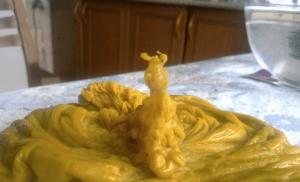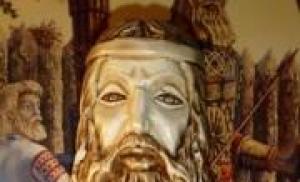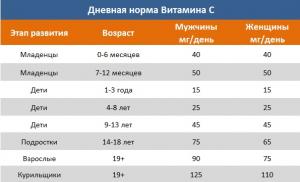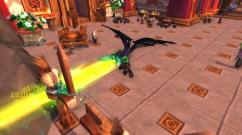Sea anemones. Sea anemones: characteristics and lifestyle Sea anemones
Any sea anemone is extraordinarily beautiful. Therefore, anemones are often called sea anemones. They received this, which has already become an official name, for their external resemblance to the flowers of plants. Indeed, the underwater landscapes, decorated with anemones sitting on them, can be compared to an exotic flower bed.
- They do not have an axial skeleton and are therefore invertebrates.
- These beauties belong to the type of coelenterates and are the closest relatives of corals.
And although anemones always live alone, and corals always form colonies, both of these groups of animals have many similarities in structure.
Dear ecological guests, today amazing video meetings with unusual animals await you!
How does the polyp of coelenterates work?
Actinia - senile metridium (Sea of Japan)
Senile metridium - anemones, the photo of which you see on this page, demonstrates the structure of an individual polyp. The polyp is the solitary form of this animal. Therefore, one sea anemone is one polyp. And the coral has many polyps that form a colony.
But the internal structure and the principle of life are the same for them. A separate polyp resembles a two-layered sac with one opening open at one end, inside which there is an "intestinal" cavity.
In this cavity, food is digested, and the opening acts as a mouth. And through the same hole, undigested food debris is thrown out of the polyp's body. The mouth is surrounded by a ring of tentacles.
Watch a fragment of a hand-drawn cartoon about how anemones eat.
Video, anemones:
So, you were attentive and saw that at first the anemones put the caught fish into the mouth, and then they threw out their skeletons from there. Amazing, isn't it?
Imagine - sea anemones are very similar in structure!
If the jellyfish is turned with the dome down, then we will see all the features of the anemone polyp:
- After all, the hole in the jellyfish is also the same - it serves as a mouth and a place for throwing out waste.
- The jellyfish has tentacles with which it catches food, and the anemones also have them.
- If you pull out the dome of the jellyfish, you get the elongated body of the anemones.
You can even try to make such a transformation of jellyfish into anemones on a plasticine model.
Mold a jellyfish from plasticine, and then pull its dome down in the form of a tube and move the tentacles closer. Attach the bottom of the tube to something sturdy, and there you have it!
What are the types of anemones?
In nature, there are a wide variety of anemones. In total, there are about 1500 species of these animals that live only in the sea. Unlike jellyfish, freshwater anemones do not exist in nature. The sizes of anemones vary over a very wide range:
- the diameter of the body of anemones is from a few millimeters to 1.5 m;
- the height can reach 1 m;
Most of the anemones have a high, elongated body in the form of a column, in the upper part of which there is a mouth surrounded by numerous long tentacles carrying stinging cells with venom. The bottom part of them is attached to the underwater substrate.
But among the sea anemones, there is one amazing family. See what these sea anemones look like in an aquarium.
Video, anemones:
In this video, you got to know the anemone called Amplexidiscus fenestrafer or the Great Elephant's Ear from the Discosoma family. Isn't it a very apt and self-explanatory name?
Representatives of the Discosomatidae family are the most amazing anemones!

The body of the discosome has the shape of a flexible disc, which is covered from the inside with cone-shaped tentacles. At the bottom of the disc there is a sole for attaching the animal to the substrate. In the upper central part of the disc there is a rather large mouth - the mouth opening.
They are painted in almost all colors of the rainbow: green, yellow, lilac, purple and others. Disc diameter - up to 40 cm
Symbiosis in the life of anemones
Anemones and hermit crab is the most common example of symbiosis (mutually beneficial cooperation) among anemones. Cancer - a hermit for anemones - is a means of transportation, as anemones move independently very slowly. Actinia, whose tentacles contain stinging cells, provides protection for hermit crab.
Anemones are coral polyps of large size, which, unlike other corals, have a soft body. Anemones belong to a separate class of coral polyps, they are also related to jellyfish. They are also called sea anemones because they look so beautiful that they look like flowers.
Features of the appearance of anemones
The body consists of a cylindrical stem and a bundle of tentacles. The leg is composed of annular and longitudinal muscles, thanks to which the anemones can stretch, shorten and bend. There is a sole or pedal disc at the bottom of the foot.
Mucus is released from the stem of the anemone, which hardens, and the anemone is glued to the substrate. Other sea anemones have wide legs, with their help they cling, like an anchor, to loose soil, and the sole with a bubble acts as a fin. These types of anemones float upside down.
At the upper end of the body is an oral disc that surrounds a row or several rows of tentacles. In one row, the tentacles are the same, but in different rows they can differ in color and size. The tentacles are equipped with stinging cells, from which thin poisonous threads fly out. The mouth opening can be oval or round.
Anemones are rather primitive creatures that do not have complex sense organs. The unequal system of anemones consists of a group of sensitive cells located on the sole, base of the tentacles and around the mouth opening. These nerve cells respond to various stimuli, for example, cells near the mouth are able to distinguish substances, but do not respond to mechanical action, and the cells on the sole do not respond to chemical action, but are sensitive to mechanical action.
Most of the anemones have a naked body, while the sea tubular anemones have a chitinous cover, their legs look like a tube, so they were called “tubular”. The bodies of some anemones are covered with grains of sand and various building materials that make the cover more durable.

The color is so diverse that even among representatives of the same species, the shade can differ. Anemones can be of all colors of the rainbow: pink, red, green, orange, white, and the like. Often, the edges of the tentacles have a contrasting color. The body size of the anemone varies over a wide range.
The body height of the smallest - gonactinia 2-3 mm, the largest is carpet anemone, up to 1.5 meters in diameter, and the height of the metridium anemone reaches 1 meter.
The habitat and habitats of anemones
Anemones live in any oceans and seas. Most of these animals are concentrated in subtropical and tropical zones, but they are also found in circumpolar regions. For example, in the seas of the Arctic Ocean, the sea carnation or the senile metridium lives.

Habitats are quite diverse: from the depths of the ocean to the surf zone. Few species of anemones live at an ocean depth of more than 1000 meters. Although most of the sea anemones are marine animals, certain species can live in fresh water. 4 species of anemones live in the Black Sea, one species lives in the Azov Sea.
Anemone lifestyle
The anemones that live in shallow waters often contain microscopic algae in their tentacles, giving them a green tint and supplying them with nutrients. These sea anemones live in lighted areas and are active mainly during the day, as they depend on photosynthesis of algae. And certain species do not tolerate light at all. The anemones that live in the tidal zone have a clear diurnal regime, which is associated with the time of drainage and flooding of the territory.
All anemones can be divided into 3 types according to their lifestyle: swimming, sedentary and burrowing. Most of the anemones are sessile; the genera Haloclava, Edwardsia, and Peachia belong to the burrowing ones, and only the genus Minyas belongs to the swimming ones.
 The anemones attach themselves to the bottom with the so-called “soles”.
The anemones attach themselves to the bottom with the so-called “soles”. Sessile anemones, contrary to their name, are capable of moving slowly. As a rule, they begin to move if something does not suit them, for example, light or lack of food. Anemones move in several ways. Some species arch the body and attach to the ground with an oral disc, then tear off the leg and transfer it to a new place. Sitting jellyfish move in a similar way. Other species move their sole, tearing parts of it alternately from the ground. And the third way - anemones lie on their side and crawl like worms, while different parts of the leg contract.
In fact, burrowing anemones do not dig so often. Most of their lives they sit, and they are called burrowing because they can bury themselves in the ground, and only the corolla of the tentacle remains visible from the outside. In order to dig a hole, the sea anemone acts in a rather interesting way: it collects water into the oral cavity, and alternately pumps it to one end of the body, and then to the other, thus it goes deep, like a worm, into the ground.

The sedentary small gonactinia is sometimes able to swim; during swimming, it rhythmically moves its tentacles, its movements are similar to the contraction of the dome. Swimming species stay on the water passively with the help of pneumocystis, and move with the help of the current.
The relationship of anemones with other marine inhabitants
Anemones lead a solitary lifestyle, but if conditions are favorable, then these polyps combine in colonies, forming beautiful flowering gardens. Basically, anemones do not show interest in their relatives, but some of them have a quarrelsome disposition. These anemones, when touched with a relative, attack it with stinging cells, which cause tissue necrosis.
But anemones often get along well with other species of animals. The most striking example of symbiosis is the life of anemones and clown fish. Fish take care of polyps, cleaning them of food debris and various debris, and anemones eat up the remains of clown fish prey. And shrimps often find shelter from enemies and food in the tentacles of anemones.
 Anemones are useful organisms. They live in tropical and subtropical waters.
Anemones are useful organisms. They live in tropical and subtropical waters. The relationship between the anemones adamsia and hermit crabs is even better. Only young Adamsia live independently, and then hermit crabs find them and attach them to their shells. In this case, the anemones are fastened with the oral disc forward, due to which they get food particles from the soil agitated by cancer. And anemones protect cancer from enemies. Moreover, when a cancer changes its house, it transfers the anemones to a new shell. If the cancer has not found its anemones, it tries to take it away from its fellow.
Nutrition of anemones
Some anemones send into the mouth cavity everything that touches their tentacles, even pebbles and other inedible objects, while others spit out what cannot be eaten.
Polyps eat a variety of animal foods. Some species filter water and extract organic waste from it, while others hunt for larger prey - small fish. For the most part, anemones feed on algae.

Breeding anemone
Reproduction in anemones can occur sexually and asexually. Asexual reproduction occurs due to longitudinal division, in this case, two individuals are obtained from one individual. This method of reproduction is found in the most primitive anemones, gonactinia. A mouth is formed in the middle of the leg of these anemones, after which the animal breaks up into two independent organisms. Since anemones are capable of asexual reproduction, they have a high capacity for tissue regeneration: in anemones, lost parts of the body are quickly restored.
Most of the anemones are dioecious. But there are no differences between males and females of anemones. In certain species of anemones, both female and male germ cells can form simultaneously.
The fertilization process in anemones can occur in the gastric cavity or in the external environment.

In the first week of life, the anemone larvae move freely in the water, due to which they are carried over long distances by the current. In some species, the larvae develop in special pockets that are on the bodies of mothers.
Unusual in beauty and rather mysterious in their way of life are sea animals - anemones. But where do anemones live? What is their appearance? We'll find out now ...
Scientists have long argued about what type of animals these creatures belong to, because they have something in common with both corals and jellyfish, and outwardly, anemones generally look like underwater plants.
The modern classification classifies it as coral polyps, moreover, these living organisms are one of the largest representatives of corals.
Another name for anemones is sea anemones, the animals received this name precisely because of the similarity with flowers.

The structure of anemones is a body consisting of a corolla of tentacles and a cylindrical stem. At the base of the leg are muscles (longitudinal and circular). The end of the leg can have a so-called sole.

Anemones are bottom plants, so they need to gain a foothold on the surface of the soil, they do this with the help of various devices.

Some representatives of this type of coral secrete a special mucus, which tends to harden over time and thus firmly fixes the animal's body on the substrate. Other anemones have such a large and strong leg that they are able to bury it in the ground and in this way reliably attach themselves to the underwater soil.

But there are exceptions among the anemones that do not live on the seabed, but freely floating in the water column. They are also called floats. In the sole of such species there is a special bubble that prevents the animal from sinking to the bottom and constantly keeps it floating.

The upper part of the leg of the anemone has a mouth opening, represented by a disc, surrounded by many tentacles, which are arranged in rows.

These very tentacles are equipped with stinging cells that can shoot out the thinnest thread, supplied with a poisonous secret. If you look at the body of the sea anemone, you can see pronounced radial symmetry.

As for the various sense organs inherent in most living organisms, the anemones in this sense can be called one of the most primitive.

The nervous system of these animals consists of sensitive cells located at the base of the tentacles, around the oral disc, and also on the sole.

The main distinguishing feature of these sea creatures is undoubtedly their color. It is not for nothing that they are called sea colors, because they have the brightest colors in their colors: pink, orange, red, white, brown, green, yellow and others. In some species, you can find a whole rainbow palette on the body, since the body is of one color, and the tentacles are painted in a contrasting shade.

The size of anemones is also surprising: the smallest representatives of this group of animals can have a millimeter height, and there are giants, whose "growth" reaches one meter.

The smallest sea anemone discovered by scientists is the gonactinia anemone (Gonactinia prolifera), its growth is only 2 millimeters.

These animals became widespread in all oceans and seas, the greatest species diversity is manifested in tropical and subtropical zones. Sea anemones have acclimatized even in the icy waters of the Arctic Ocean.

By the way they feed, the anemones are predators. Some species swallow everything in themselves (both stones and paper), others, after accidentally swallowing an extra object, spit out the unnecessary.
Yellow sand, waves beating against the shore, tropical trees, and the water in the sea is so transparent that you can see stones and ... flowers at the bottom. Flowers?
But how can they grow underwater? This does not happen! Although this statement can still be argued. Indeed, you are not mistaken, at the bottom of the sea you can see sea inhabitants of extraordinary beauty - anemones, which got their name for their resemblance to the Anemone flower.
But here animals are like flowers. Anemone is not a plant, but an animal that we all know better as.
Anemones or sea anemones are close relatives of corals, but if corals are colonies of polyps, anemones are large polyps themselves.
Their structure is very simple and has undergone small changes over millions of years. They are practically a "leather bag" that is inflated with water, which gives them a certain shape.

Attaching to the bottom or to the stones and shells lying on the bottom, sea anemones gracefully swing their "petals" like flowers in the wind.
The cylindrical body-stem ends at the top with a delicate rim of numerous petals-tentacles.
And what colors are not found in nature: pink, green, blue, yellow, purple and purple.
Their size sometimes does not exceed a few millimeters, and sometimes reaches 15 centimeters. It all depends on the type of anemones, and there are not many, not less than 1,500, found in almost all seas of the world, except for the Caspian and Aral.
They live in arctic latitudes and at the equator, in the sands on the coast and in the depths of lightless sea over 10,000 meters. However, most species of anemones prefer shallow coastal waters and water with a fairly high salinity. Some species have a suction cup for attaching to something, while others bury their feet in the soil. For a millionth existence, they have not undergone small changes.



But such beauty is far from safe for other marine life.
The sea anemone is carnivorous. As soon as a small fish or shrimp touches the "petals" of a plant, or rather it would be more correct to call it an animal from now on, it will immediately receive a share of a strong paralyzing poison. Further, the tentacles direct the prey to the center of the corolla, to the mouth opening, where the juice of the pharynx and stomach is finally dealt with it.
Also, the tentacles serve not only as a food collector, but also as a protector from larger marine life, which are not averse to feasting on anemones. Among the anemones, there are both peaceful species that suck nutrients from the sea water, and predators.
And there are such "smart" anemones-predators who know how to distinguish between edible and inedible, and there are others, especially hungry, who drag everything into their mouths indiscriminately, even objects dangerous to them.

One gets the impression that anemones are such a small bloodthirsty monster at the bottom of the seas, and the desire to touch the curiosity with your hands immediately disappeared. And for good reason.
There are giant anemones (Stoichactis spp., Condylactis spp.) And tubular anemones (Pachycerianthus spp.) That have dangerous stinging processes and should not be touched with bare hands, especially in sensitive areas such as the outer elbow or the back of the hand. One touch can get burned like a poisonous jellyfish.






You will learn about other "colors" of the sea - corals in the topic
Dear readers, don't forget - you have the right to vote -
give your opinion on the topic
Anemones
| Anemones | ||||||||
Anemones in a drawing by Ernst Haeckel (1904) |
||||||||
| Scientific classification | ||||||||
|---|---|---|---|---|---|---|---|---|
| International scientific name | ||||||||
|
Actiniaria Hertwig, |
||||||||
|
||||||||
Sea anemones, or sea anemones(lat. Actiniaria) - a detachment of sea creepers from the class of coral polyps ( Anthozoa). Representatives are devoid of a mineral skeleton. Typically solitary forms. Most anemones are sedentary organisms that live on solid ground. Few types (for example, Nematostella vectensis) switched to a burrowing way of life in the thickness of bottom sediments.
Body structure
The cylindrical body of anemones varies in diameter from a few mm to 1.5 meters.
Their length varies from 1.5 to 10 cm.The record height (1 m) is Metridium farcimen from the Northwest Pacific coast of the United States. Attached to hard substrates using a "sole" (pedal disc). In burrowing forms that live on soft soils (for example, on sand), special attachment organs are not formed, but the extended basal end of the body forms a swelling (fizu), resembling an onion or mushroom in shape and serving for anchoring in the ground. Unusual tropical anemones of the genus Minyas(some species of this genus are colored sea green) in the swelling of the pedal disc is a chitinous bladder filled with air. These anemones passively hover "upside down" near the surface of the water. Similar adaptations to life in neuston have arisen in hydroid polyps Velella and Porpita, which can be considered as an example of parallelism in the evolution of representatives of different taxa.
Anemones in most cases carry six or more than eight simple tentacles tapering towards the end. There is often a terminal pore at the tip of each tentacle. In a number of species, the tentacles branch, have extended tips ("knobs"), or, conversely, are reduced to the state of numerous low bumps, evenly covering the entire oral disc, as, for example, in anemones from the genus Stoichactis... Some anemones (for example, representatives of the genera Actinia and Anthopleura) are protected from competitors with the help of special tentacular outgrowths - acrorags... These outgrowths extend from the body somewhat below the bases of the true tentacles. Acrorags carry nematocysts and are capable of swelling. Anemones resort to this "weapon" when they come into contact with representatives of another species or with anemones of the same species, but a genetically different clone. The collision results in tissue damage and the retreat of one or both competitors.
The body of anemones is usually uniform along the entire length from the oral to the pedal disc, but in some species the upper body, lying just below the oral disc and tentacles, is a neck-like thin-walled introvert, or capitulum... The body wall below the introvert is usually thicker. The transitional area between the introvert and the rest of the body often bears a collar fold (parapet), like a childbirth Actinia, Metridium and Urticina... When the oral disc, the tentacles, and the capitulum are pulled inward during the contraction of the polyp, the transition region narrows so that the parapet covers and protects the remaining opening. The constriction is caused by the contraction of the sphincter muscle located in the epidermis or in the mesoglea.
Outside, the body wall can be more or less smooth and undifferentiated, or it can carry specialized structures. Dense papillae cover the body Haloclava producta and Bunodosoma cavernata... Rows of adhesive papillae (warts) cover the body of other anemones, for example Anthopleura, Urticina, Bundosoma and Bunodactis... Grains of sand and fragments of mollusk shells are attached to these papillae, which protect the body of the animal. Some anemones have zincclides, through which water and aconces, if any, are thrown out during the contraction of the body. Anemones (species of the genus Bunodeopsis), above the surface of the body of which separate or organized into groups of thin-walled vesicles (vesicles) containing zooxanthellae are protruded.
Some anemones have one siphonoglyph, but usually two siphonoglyphs. There are usually both complete and incomplete pairs of septa. Their number is never less than 12, and often much more. Acconia may or may not be present. Stocked sea anemones (such as Aiptasia, Bartholomea and Metridium) are called acontiate. The longitudinal muscle cords in the septa are exceptionally well developed. They are attached to the oral and pedal discs and are primarily responsible for the retraction of the oral disc and tentacles, as well as for the contraction of the entire body.
At the pole of the body, facing away from the substrate, there is a slit-like mouth surrounded by a rim of tentacles.
Anemones are devoid of a mineral skeleton: the intestinal cavity takes on a supporting function, which is isolated from the environment when the mouth is closed. The coordinated work of this hydroskeleton and the muscles of the body wall turns out to be quite effective: among the anemones there are representatives capable of moving in the thickness of the soil. Most anemones are capable of strongly contracting and expanding, which means that their shape and size depend on the specific circumstances in which they find themselves at a given time. Some species secrete chitinous periderm, which is used to a greater extent for protection. The peridermis is usually confined to the pedal disc or body wall below the introvert. The most intense formation of chitin is characteristic of pelagic anemones from the genus Minyas, as well as for representatives of the group of deep-sea, so-called frilled anemones (genus Stylobates).
Anemones, which are usually attached to the substrate, can slowly "slide" along it due to the contraction of the muscles of the pedal disc. Digging forms make holes in the ground due to the peristaltic contractions of the body, while the movement is carried out by the pedal pole forward. Some anemones can "walk" on tentacles, and Gonactinia prolifera(an organism the size of a hydra) swims, striking the water with its tentacles. Large sea anemone Stomphia Usually attached to the substrate, but when a predatory starfish tries to attack it, the anemones can separate from the substrate and swim due to the flapping of the lower part of their body.
Many anemones are brightly colored: they can be white, green, blue, orange, red, and also multi-colored.

USSR stamp
Ecology and nutrition
They feed on various small invertebrates, sometimes fish, first killing or paralyzing prey with "batteries" of stinging cells (cnidocytes), and then pulling them to the mouth with the help of tentacles. Large species feed on crabs, bivalve molluscs, which are washed away by the waves. The lip-forming edges of the mouth can swell and also aid in capturing prey. Anemones with numerous tentacles, such as Metridium, Radianthus and Stichodactyla, feed on particles suspended in water, but there is evidence that Stichodactyla helianthus catches sea urchins by covering them with its muscular oral disc. Forms that feed on particles suspended in water trap plankton inhabitants with the help of mucus that covers the surface of the body and tentacles. The cilia on the surface of the body always strike in the direction of the oral disc, and the cilia on the tentacles provide the movement of food particles to their tips. The tentacles then bend and convey the food into the mouth.
The gastrodermis of many anemones contains zooxanthellae, zoochlorella, and sometimes both. They are especially abundant in the tentacles and the oral disc. Individual color variability Anthopleura elegantissima determined by the predominance of zoochlorella or zooxanthellae. Tropical anemone Lebrunia danae has two "sets" of tentacles: a corolla of simple tentacles for catching prey and a corolla of "pseudo tentacles" containing zooxanthellae. The pseudo-tentacles, in which photosynthesis is carried out thanks to symbionts, are straightened during the day, and the tentacles for catching prey - at night.
A person can cause painful burns.
Symbiosis
Sea anemones and hermit crabs form symbiotic systems that are very common and often found in the seas. As a rule, one or more anemones live on one crayfish. Anemones are believed to benefit from this cohabitation in a variety of ways: having a substrate (the hermit crab's shell) for attachment, transporting them to food sources, including dripping food pieces from feeding crayfish, and protecting them from predators. Encounters of hermit crabs probably provide an opportunity for reproduction not only for themselves, but also for anemones. Cancers, in turn, receive passive protection from anemones (anemones camouflage their partner in a symbiotic system well) and active protection in the form of numerous nematocysts. Most importantly, anemones scare away cancer enemies such as octopuses and crabs of the genus Calappa... When the hermit crab "grows" from its shell and, having molted, looks for a larger shell, it helps the anemones move to a new place of residence. To do this, the cancer strokes the anemone, stimulating the relaxation of its pedal disc, and then moves it to the surface of the new shell. Some species of anemones move on their own to a new shell, making a "roll over their head".
As hermit crabs grow, they look for larger and larger shells of gastropods. At the moment of "resettlement", the cancer is virtually defenseless, since at this time it becomes vulnerable to predators. Sometimes he also has to go into battle with other hermit crabs, because there are often not enough suitable shells for everyone. Anemones from the genus Stylobates with the help of their widened and flattened pedal disc, they form a chitinous "surrogate" shell, which the crayfish occupies - in deep-sea areas where these hermit crabs and their anemones live, there are few suitable shells. Since anemones not only create a shell, but gradually build it up, cancer avoids the dangers associated with shell change. Anemones Stylobates also benefit, because they are not left "unattended" when changing sinks. In addition, the hermit crab can ward off enemies of the sea anemone and accidentally share food with it.
Small Indo-Pacific fish of the genus Amphiprion(clown fish) live between the tentacles of large anemones, entering into a symbiotic relationship with the latter. Anemones "recruit" young fish, releasing substances that attract them (attractants). Attractants are species-specific, that is, they attract organisms of only a certain type. The mucus covering the fish does not contain substances that initiate the shooting of nematocysts, so they can exist between the tentacles of anemones in a habitat that is deadly to other animals. Actinia provides the fish with protection and food debris, and the fish attract prey (fish of other species) to the “owner”, protect it from some predators (butterfly fish), remove necrotic tissue, and also, swimming between the tentacles, “ventilate” the anemone, preventing silt contamination.
In addition, anemones also form symbiotic systems with some amphipods, shrimps of the genus Periclimenes, click crabs, crabs of the genus Stenorhynchus and ophiuras.
Reproduction
Asexual reproduction
Spreading
Widespread. Sea anemones inhabit deep ocean or coastal shallow waters around the world. Most live in tropical and subtropical waters. According to rough estimates, the number of species of anemones is 1350. Anemones attach to rocks, shells of molluscs and flooded wooden objects, or they dig in silt or sand.
see also
Notes (edit)
Literature
- Dogel V.A., Zoology of invertebrates, 5th ed. - M., 1959.
- Animal life, t. 1. - M., 1968, p. 299-306.
- Ruppert E.E., Fox R.S., Barnes R.D. Protists and lower multicellular organisms // Zoology of invertebrates. Functional and Evolutionary Aspects = Invertebrate Zoology: A Functional Evolutionary Approach / per. from English T. A. Ganf, N. V. Lentsman, E. V. Sabaneeva; ed. A. A. Dobrovolsky and A. I. Granovich. - 7th edition. - M .: Academy, 2008 .-- T. 1. - 496 p. - 3000 copies. - ISBN 978-5-7695-3493-5
- // Encyclopedic Dictionary of Brockhaus and Efron: In 86 volumes (82 volumes and 4 additional). - SPb. , 1890-1907.
Wikimedia Foundation. 2010.
See what "Anemones" is in other dictionaries:
Sea anemones (Actiniaria), an order of six-rayed corals. Solitary (rarely colonial) skeletal polyps. Body from several. mm up to 1.5 m in diameter, with a corolla of tentacles, usually brightly colored. OK. 1500 species, in all seas, from the littoral to the depths ... Biological encyclopedic dictionary
- (sea anemones, sea nettles) beautiful, brightly colored marine animals from cl. polyps. Fleshy body, with a suction plate at the bottom, a mouth opening at the top, surrounded by long tentacles, giving the anemones the appearance of a flower. Dictionary… … Dictionary of foreign words of the Russian language
- (sea anemones) a detachment of marine coelenterates of the class of coral polyps. OK. 1500 kinds. Sizes from a few millimeters to 1.5 m. Single polyps, devoid of a skeleton; tentacles with stinging cells. Mainly in tropical and ... ... Big Encyclopedic Dictionary
ACTINIA- ACTINIA, sea anemones, sedentary animals from the type of coelenterates (Soy lenterata) and the subclass of coral polyps; A. represent skeletal single polyps with a fleshy body in the form of a sac, the inlet of which is surrounded by many ... ... Great medical encyclopedia
ACTINIA, detachment of marine coelenterates; solitary skeletal coral polyps. The body is from a few mm to 1.5 m, with a corolla of tentacles (touching them can cause a burn in a person). Usually brightly colored (reminiscent of fantastic flowers). About… … Modern encyclopedia













